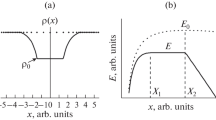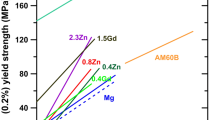Abstract
A calculation of the plateau stress in solid solution crystals is presented assuming an arbitrarily oriented dislocation loop of lengthL, that moves under an applied stress. At high concentrations of solute atoms the dislocation segment does not interact with an individual solute atom but instead with all the solute atoms along the dislocation segment within a certain radius. The macroscopic flow stress is assumed to be determined by the maximum force that is encountered when a dislocation is moved over a distance equal to the distance between the position at zero stress and the critical position of an activated Frank-Read source. If the dislocation segment is assumed to be large compared to atomic distances, the interaction with groups of atoms will lead to an athermal process and therefore can explain the origin of the temperature independent flow stress in solid solution crystals. From this model the flow stress can be calculated with the help of statistical methods similar to those used in calculations of the movement of Bloch walls in magnetic materials. Besides the proper temperature dependence of the plateau stress the above model yields a dependence of the plateau stress upon the square root of the solute concentration, a result that is in good agreement with the measurements on silver, gold, and copperbased alloys. A linear relation between the solid solution hardening parameter dT/d√c and the strength of the solute atoms is obtained which is confirmed by the experimental results on copper-based alloys.
Similar content being viewed by others
References
A. Seeger:Phil. Mag., 1955, vol. 46, pp. 1194–1217.
A. Seeger:Kristallplastizität Handb. d Physik, p. 171, vol. VIIJ2, Springer-verlag, Berlin, 1958.
P. Haasen:Z. Metallic., 1964, vol. 55, pp. 55–60.
P. Haasen:Physical Metallurgy, R. W. Cahn, ed., p. 821, John Wiley and Sons, Inc., New York, 1965.
W. Frank:Z. Naturforsch., 1967, vol. 22a, pp. 365–76.
W. Frank:Phys. Status Solidi, 1967, vol. 19, pp. 239–50.
O. Boser:The Interactions Between Dislocations and Point Defects, AERE-R 5944, 1968, vol. 13, pp. 693–715, Atomic Energy Research Establishment, Harwell, Berkshire.
O. Boser: GTE Labs., Bayside, New York, unpublished research, 1970.
C. Zener:AIME Trans., 1943, vol. 152, pp. 122–26.
A. S. Nowick and D. P. Seraphim:ActaMet., 1961, vol. 9, pp. 40–48.
C. Y. Li and A. S. Nowick:ActaMet., 1961, vol. 9, pp. 49–58.
D. P. Seraphim and A. S. Nowick:ActaMet., 1961, vol. 9, pp. 85–97.
R. L. Fleischer:The Strengthening of Metals, D. Pecker, ed., p. 93, Reinhold Publishing Company, N. Y., 1964.
A. J. E. Foreman and M. J. Makin:Phil. Mag., 1966, vol. 14, pp. 911–24.
A. J. E. Foreman:Phil. Mag., 1967, vol. 15, pp. 1011–21.
U. F. Kocks:Phil. Mag., 1966, vol. 13, pp. 541–66.
U. F. Kocks:Acta Met, 1966, vol. 14, pp. 1629–31.
U. F. Kocks:Can. J. Phys., 1967, vol. 45, pp. 737–55.
N. F. Mott and F. R. N. Nabarro:Report on Strength of Solids, p.l, The Physical Society, London, 1948.
N. F. Mott:Imperfections in Nearly Perfect Crystals, pp. 173–96, John Wiley and Sons, New York, 1952.
J. Friedel:Les Dislocations, p. 379, Gauthier-Villars, Paris, 1956.
J. Friedel:Electron Microscopy and Strength of Crystals, p. 605, Interscience, New York, 1963.
R. L. Fleischer:,Acta Met., 1963, vol. 11, pp. 203–09.
T. Suzuki:Dislocation Dynamics, p. 551, McGraw-Hill Book Co., New York, 1968.
W. Hume-Rothery:Elements of Structural Metallurgy, p. 107, Institute of Metals, 1961.
A. H. Cottrell:Dislocations and Plastic Flow in Crystals, p. 129, Clarendon Press, Oxford, 1953.
J. W. Christian:The Interactions Between Dislocations and Point Defects, B. L. Eyre, ed., 1968, vol. III AERE-R 5644, H.M.S.O. Harwell, p. 604.
E. Orowan:Symp. on Internal Stresses in Metals and Alloys, pp. 47–59, Inst. of Metals, London, 1948.
E. Orowan:Dislocations in Metals, p. 37, AIME, New York, 1954.
B. R. Riddhagni and R. M. Asimow:J. Appl. Phys., 1968, vol. 39, pp. 4144–51.
B. R. Riddhagni and R. M. Asimow:J. Appl. Phys., 1968, vol. 39, pp. 5169–73.
R. Labusch:Phys. Status Solidi, 1970, vol. 41, pp. 659–69.
T. Stefansky and B. E. Dorn:Trans. TMS-AIME, 1969, vol. 245, pp. 1869–76.
L. Johnson and M. F. Ashby:Acta Met, 1968, vol. 16, pp. 219–25.
M. Peach and J. S. Koehler:Phys. Rev., 1959, vol. 80, pp. 436–39.
H. Träuble:Mod. Probl. Metallphys., 1966, vol. 2, p. 332.
H. Träuble, H. Kronmuller, A. Seeger, and O. Boser:Mater. Sci. Eng., 1966, vol. l,pp. 167–76.
H. Bilger and H. Träuble:Phys. Status Solidi, 1965, vol. 10, pp. 755–64.
B. V. Gnedenko and A. N. Kolmogorov: p. 1, Addison-Wesley Publ. Corp., Reading, Mass., 1968.
W. Feller:An Introduction to Probability Theory and Its Applications, vol. 1, p. 43, John Wiley and Sons, Inc., New York, 1966.
H. Cramer: Mathematical Methods of Statistics, p. 370, Princeton Univ. Press, Princeton, 1958.
P. Jax, P. Kratochvil, and P. Haasen:Acta Met, 1970, vol. 18, pp. 237–45.
G. Kostorz and P. Haasen:Z. Metallk., 1969, vol. 60, pp. 26–28.
P. Haasen:Dislocation Dynamics, A. R. Rosenfield, G. T. Hahn, A. L. Bernent, and R. I. Jaffe, eds., p. 570, McGraw-Hill Book Co., New York, 1968.
Author information
Authors and Affiliations
Rights and permissions
About this article
Cite this article
Boser, O. The temperature independent plateau stress of solid solution crystals. Metall Trans 3, 843–849 (1972). https://doi.org/10.1007/BF02647658
Received:
Published:
Issue Date:
DOI: https://doi.org/10.1007/BF02647658




